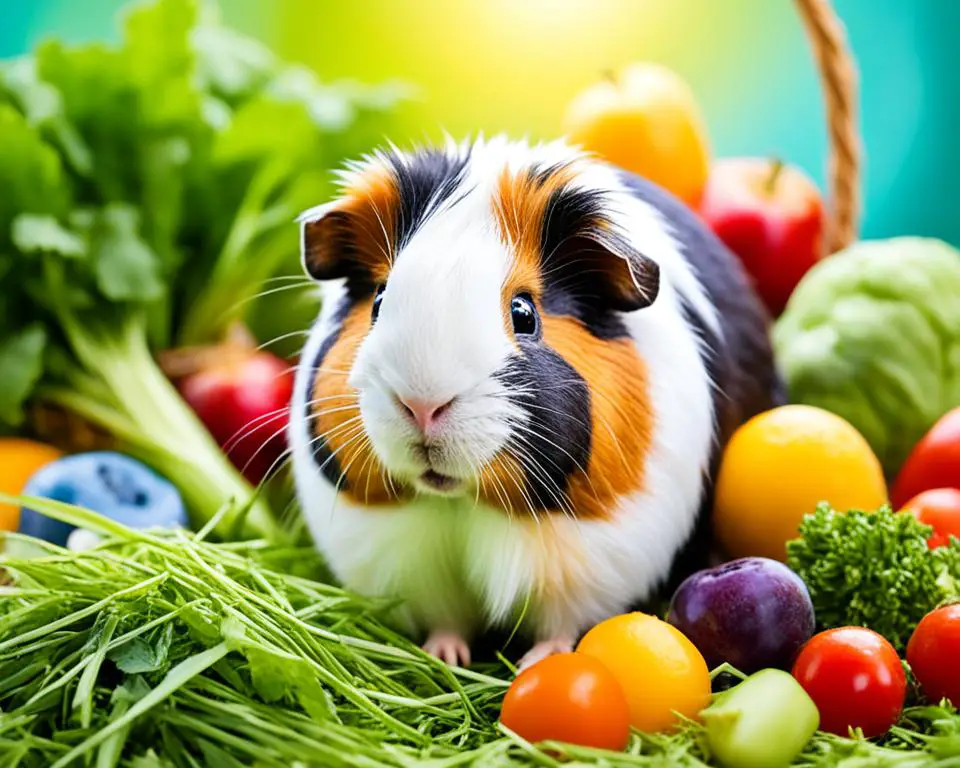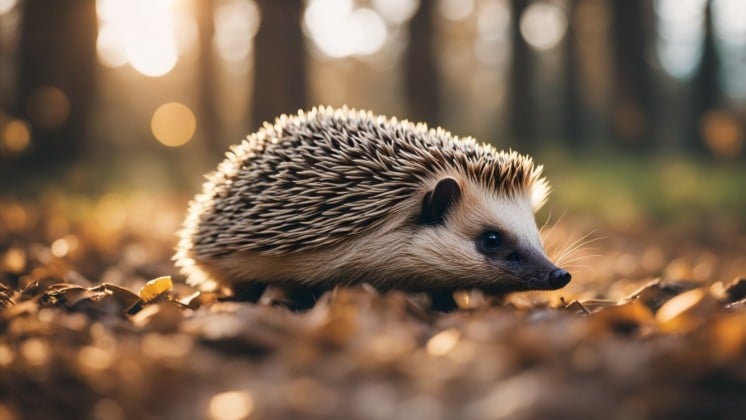Are you a guinea pig owner curious about their diet and wondering, “Can Guinea Pigs Eat Arugula?”? Here’s an interesting fact: guinea pigs can eat arugula but it should be given in moderation due to its calcium content.
In this blog post, we’ll guide you through the nutritional benefits and potential risks of feeding your pet rodent this leafy vegetable. Stay tuned to learn everything about including arugula safely in your furry friend’s meal plan!
Key Takeaways
- Arugula is safe for guinea pigs to eat in moderation due to its calcium content.
- Feeding arugula twice a week as part of a varied diet provides nutritional benefits for guinea pigs, such as vitamins and minerals essential for their overall health.
- It’s important to be mindful of potential risks when feeding arugula to guinea pigs, including stomach discomfort, high calcium levels, excess vitamin A intake, and potential allergic reactions.
Is arugula safe for guinea pigs?

Arugula is generally safe for guinea pigs, but it should be fed in moderation due to some potential risks.
Moderation is key
Guinea pigs relish the tangy, peppery flavor of arugula, but it’s vital to exercise moderation while feeding them this leafy green. Just like any vegetable in their diet, too much arugula might cause stomach discomfort.
To ensure a balanced and varied diet for guinea pigs, dietary guidelines recommend feeding arugula stems along with leaves just twice a week. This frequency keeps the nutritional density in check without overwhelming your little pet’s digestive system.
Variety in their vegetable intake promotes overall health and well-being among guinea pigs.
Nutritional benefits
Arugula is a leafy green packed full of nutrients that guinea pigs need. This healthy food source provides vitamins and minerals, essential for their overall health. Your furry friend will get a balanced intake of nutrients from including arugula in their diet.
This low-calorie vegetable offers plenty to keep your pet hopping with joy. Arugula satisfies the dietary recommendations needed for guinea pigs to thrive. From promoting better eyesight to boosting immunity, these nutritional benefits play a vital role in supporting guinea pig’s individual requirements.
Enjoy feeding your pets this nutritious vegetable knowing it contributes positively to their well-being!
Nutritional analysis of arugula
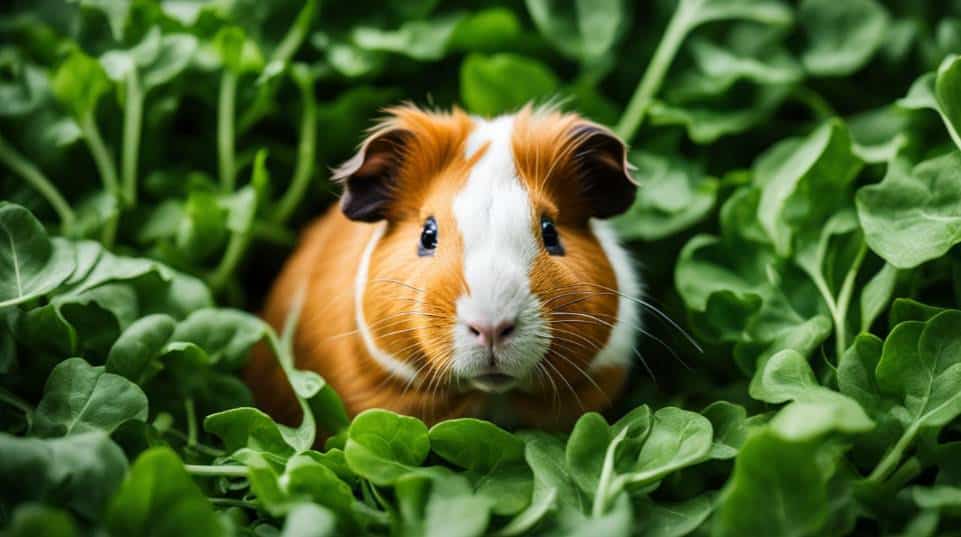
Arugula is packed with essential vitamins and minerals that can benefit guinea pigs’ overall health. It is high in antioxidants, which have anti-cancer properties and support heart health.
Vitamins and minerals
Arugula is a rich source of vitamins and minerals essential for guinea pig health. It contains vitamin C, which guinea pigs can’t produce themselves and must get from their diet. This vitamin plays an important role in strengthening the immune system of these pet rodents.
Arugula also has Vitamin K, necessary for bone health and blood clotting functions. Additionally, it provides vital minerals such as iron for proper oxygen transport in the body and calcium that contributes to strong bones in your furry friend.
Given its packed nutritional punch, arugula makes an excellent choice to add variety to your guinea pig’s diet while supplementing their necessary nutritional needs.
High in antioxidants and anti-cancer properties
Arugula is a leafy green that is high in antioxidants and boasts anti-cancer properties. These antioxidants help protect the body from harmful free radicals, reducing the risk of cell damage and certain types of cancer.
By including arugula in their diet, guinea pigs can benefit from these cancer-fighting properties while enjoying a flavorful and nutritious treat.
Supports heart health
Arugula plays a role in supporting heart health for both humans and guinea pigs. This leafy green is linked to a lower risk of heart disease and stroke, making it a valuable addition to their diet.
It contains arugula flowers, which are rich in enzymes and calcium, known for their ability to support cardiovascular health. In addition, arugula is packed with vitamins and minerals like Vitamin A and Iron that contribute to overall heart health.
With its flavorful taste, arugula can be easily incorporated into sandwiches or meals promoting heart health for your furry friend.
Risks of feeding arugula to guinea pigs
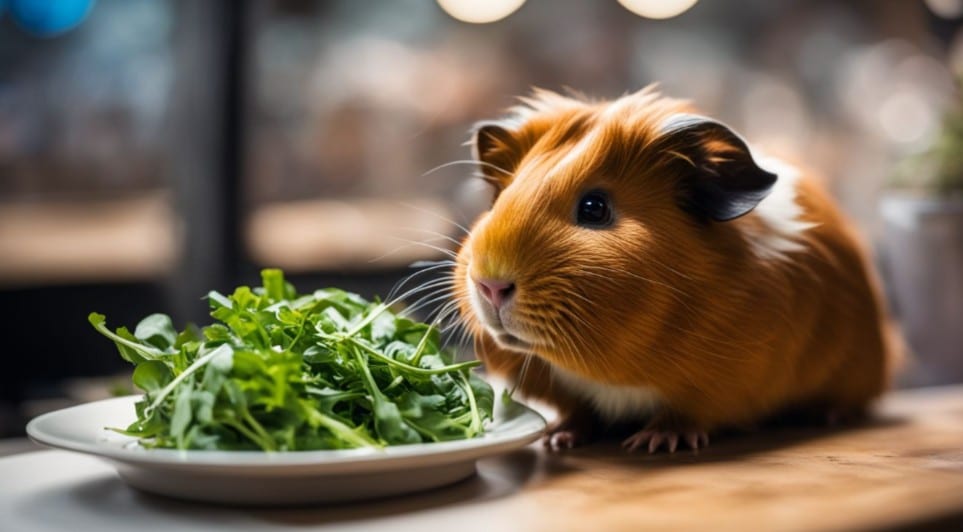
Feeding arugula to guinea pigs can pose risks such as stomach discomfort, high calcium levels, excess vitamin A intake, and potential allergic reactions.
Stomach discomfort
Guinea pigs have sensitive digestive systems, which makes them prone to stomach discomfort when introduced to new foods like arugula. Feeding guinea pigs excessive amounts of arugula can cause digestive issues such as diarrhea and intestinal problems.
It is important to monitor their consumption and make sure they are not eating too much arugula to avoid potential health complications like bladder stones and sludge formation. So, it’s crucial to introduce this leafy green in moderation and ensure that your guinea pig’s sensitive stomach is well taken care of.
Calcium levels
Arugula contains high levels of calcium, which can be both beneficial and risky for guinea pigs. While calcium is important for their bone health and overall development, excessive intake can lead to problems with their urinary system.
Feeding arugula in moderation helps control the amount of calcium they consume and reduces the risk of kidney stones or other complications. It’s crucial to maintain a balanced diet for guinea pigs by offering a variety of foods that are high in nutrients but low in calcium.
High in vitamin A
Arugula is a leafy green that is high in vitamin A, making it beneficial for guinea pigs. Vitamin A plays an important role in maintaining their overall health and well-being. It helps support their immune system, keeps their skin and coat healthy, and promotes good vision.
Guinea pigs need a sufficient amount of vitamin A in their diet to ensure proper growth and development. Including arugula as part of their balanced diet can provide them with the necessary nutrients for optimal eye health and skin health.
Potential allergic reactions
Guinea pigs can potentially have allergic reactions to arugula, which is a concern for owners. It’s important to be aware that some guinea pigs may not tolerate arugula well and could experience stomach discomfort or other adverse effects.
This risk should be taken into consideration when deciding whether or not to feed arugula to your guinea pig.
Preparing and feeding arugula to guinea pigs
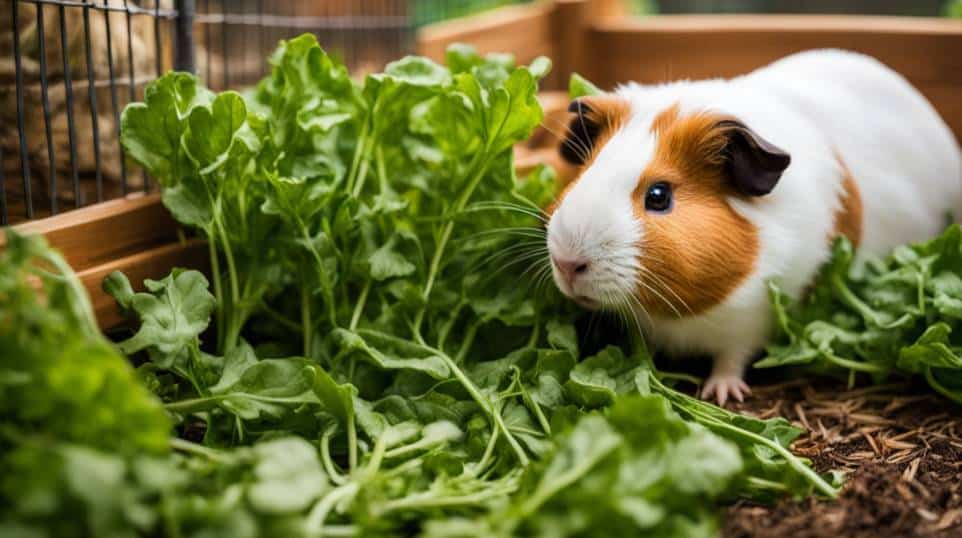
To introduce arugula to your guinea pigs, start by offering small amounts as a treat and gradually increase the serving size over time. Wash the arugula thoroughly to remove any dirt or pesticides, then chop it into bite-sized pieces for easy consumption.
Serve it alongside their regular hay and pellets to provide a healthy variety in their diet.
Introduction to new foods
Introducing new foods to your guinea pig’s diet is an important step in providing them with a balanced and nutritious meal. Leafy greens like arugula are a great addition to their menu, but it’s crucial to introduce them gradually.
Guinea pigs have sensitive digestive systems, especially when they’re young, so it’s best to start with small amounts of arugula and observe how they react. By slowly incorporating new vegetables into their diet, you can ensure that your furry friend maintains good digestive health while enjoying a variety of tasty and vitamin-rich foods.
How to prepare and serve arugula
To prepare and serve arugula for your guinea pig, follow these simple steps:
- Purchase fresh, organic arugula from a trusted source.
- Thoroughly wash the arugula leaves under cool running water to remove any dirt or pesticides.
- Chop the arugula into small, bite – sized pieces, including the flowers and stems.
- Place the chopped arugula in a clean bowl or plate.
- Offer 2 – 3 mature arugula leaves to your guinea pig once or twice a week as a healthy snack.
- Remember to provide fresh, clean drinking water for your guinea pig at all times.
Fun facts about arugula
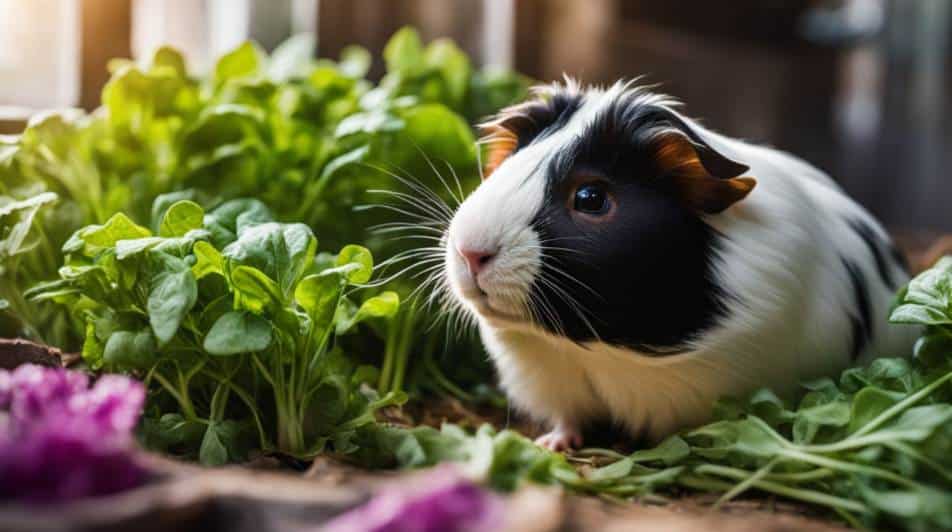
Arugula, also known as salad greens or herbaceous plants, is a leafy green that is loved by guinea pigs. Here are some interesting facts about arugula:
- Arugula belongs to the same family as kale and broccoli, making it a nutritious choice for your furry friends.
- It has been consumed since ancient Roman times and was considered an aphrodisiac by the Romans.
- The strong peppery flavor of arugula comes from compounds called glucosinolates, which have anti-cancer properties.
- Arugula is rich in vitamin C, which helps boost the immune system of guinea pigs.
- This leafy vegetable can help support heart health due to its high levels of potassium and nitrates.
These fun facts about arugula show just how beneficial this vegetable can be for your guinea pig’s diet. Incorporating arugula into their meals will not only provide them with essential vitamins but also add variety to their diet.
So go ahead and introduce this leafy green to your guinea pig’s menu!
Other fruits and vegetables safe for guinea pigs
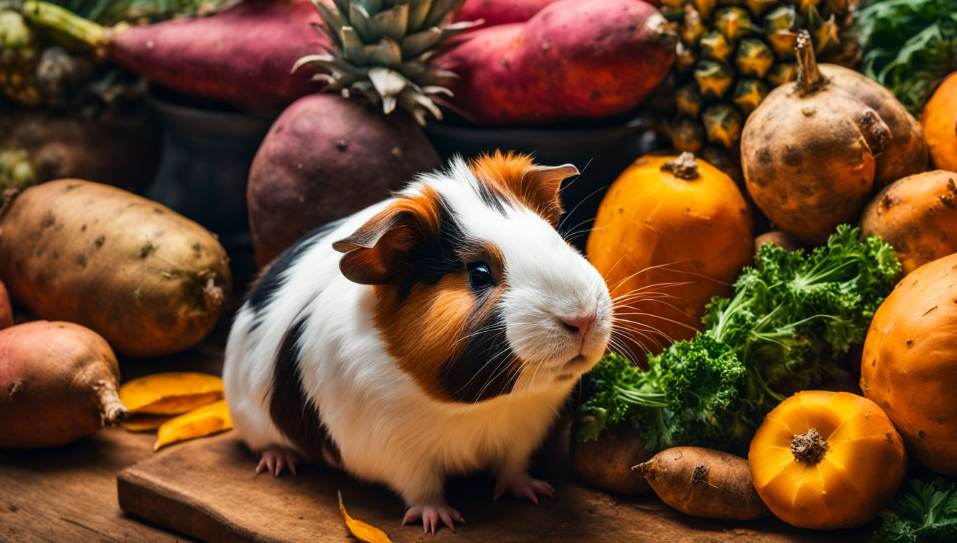
Sweet potatoes, parsley, pineapple, and a variety of recommended hay types are all safe fruits and vegetables for guinea pigs.
Sweet potatoes
Sweet potatoes are a safe and healthy addition to a guinea pig’s diet. These root vegetables are packed with essential nutrients and vitamins that can benefit your furry friend. You can even feed sweet potato peelings to guinea pigs, as long as they are free from any seasonings or additives.
So go ahead and introduce some sweet potatoes into your guinea pig’s menu for a nutritious and tasty treat.
Parsley
Parsley is a safe and nutritious herb for guinea pigs to enjoy. This leafy green is packed with vitamins and minerals that are beneficial for their health. Guinea pigs can eat parsley along with other fruits and vegetables, making it a versatile addition to their diet.
It is no wonder that parsley is popular among these small pets, as it provides plenty of nutritional benefits. So go ahead and offer some fresh parsley to your furry friend – they’ll love the taste and reap the rewards of this nutrient-rich herb.
Pineapple
Pineapple is a fruit that can potentially cause mouth and digestive tract irritation in guinea pigs due to its high acidity. While pineapple can be included in their diet occasionally, it’s important to take into consideration its acidity levels.
Guinea pigs should only have small amounts of pineapple as excessive consumption may lead to discomfort and other health issues.
Recommended hay types
Guinea pigs should primarily be fed Timothy hay, which is an essential part of their diet. It should make up about 90% of what they eat. Other suitable types of hay for guinea pigs include orchard, grass, and oat hay.
These different varieties provide important nutrients and help to prevent digestive problems in guinea pigs. Providing a varied diet that includes different types of hay ensures that guinea pigs receive all the necessary nutrients for their overall health and well-being.
FAQs
1. Is arugula safe for guinea pigs to eat?
Yes, guinea pigs can safely eat arugula as part of their balanced diet.
2. How much arugula should I feed my guinea pig?
You can offer a small handful or about 1 cup of fresh arugula leaves per day to your guinea pig.
3. Can too much arugula be harmful to guinea pigs?
Feeding excessive amounts of arugula or any other greens can lead to digestive issues in guinea pigs, so it’s important to provide variety and moderation in their diet.
4. Are there any potential health benefits of feeding arugula to guinea pigs?
Arugula is rich in vitamin C and other nutrients that are beneficial for the overall health and immune system function of guinea pigs.
5. Should I always wash arugula before feeding it to my guinea pig?
Yes, it is important to thoroughly wash arugula (or any other vegetables) before feeding them to your furry friend in order to remove any dirt, pesticides, or contaminants that may be present on the leaves.
Conclusion
In conclusion, guinea pigs can safely eat arugula in moderation. While it may not have as many nutrients as other vegetables, arugula is still a good addition to their diet. Just remember to offer it a couple of times a week and watch out for any potential digestive issues.
So go ahead and let your furry friend enjoy the leafy goodness of arugula!
Want to learn more about guinea pigs?
Ready to boost your knowledge to the next level? If so, check out the articles below:




